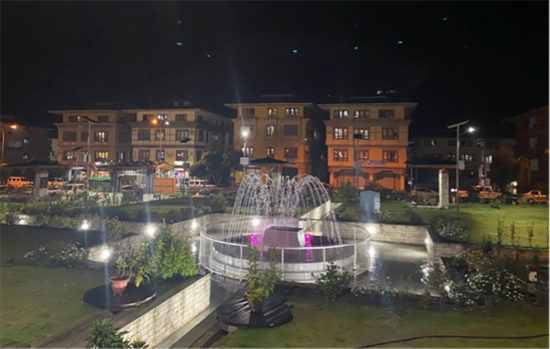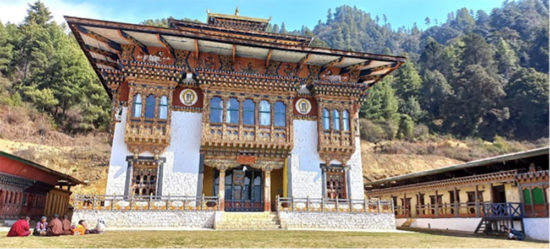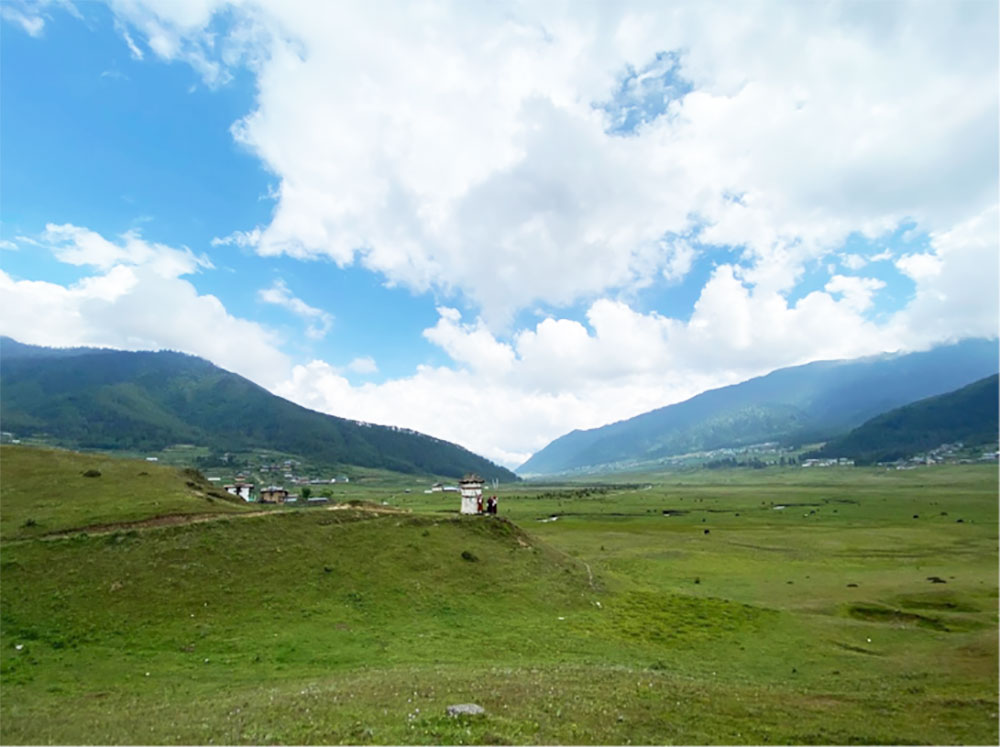Most travelers have only explored Gangtey and Phobjikha valleys in Wangdue — the district, indeed, has a several other unexplored attractions waiting to be discovered.
Samtengang Lake
It takes over two hours’ drive to reach Wangdue from the capital city of Thimphu. If you are fond of serene lakes, Luetshokha lake, commonly known as Samtengang lake, is waiting to be discovered. It is located about 10 kms from the main highway (Chuzomsa). The size of the lake is around 2 kms in circumference and has a concrete footpath around the lake for people to walk around. There is a beautiful oral story behind how the lake was formed. The locals still make offerings to the lake every year to remember the story, and to pray for wealth and prosperity of the community.

Samtengang Lake
Morakhar Lhakhang
Locals believe that Guru Rinpoche along with Khandrom Mendarawa were on their way to Bumthang. To avoid the cold weather of Bumthang, the Khandrom stayed back at this place today known as Morakhar Lhakhang. Morakhar literally means ‘Mo’ refers to her or khandrom Mendarawa and ‘Khar’ means the place. The main relic of the lhakhang is Chador statue which was one of the treasures discovered by Terton Pema Lingpa. It is believed there are only three of such statues, of which two are at Wangdue Dzongkhag, one at this lhakhang and one at Wangdue Dzong. There are even stories that during Khandrom’s stay at the place she planted betel leaves, and weaved to save her boredom. The loom can still be seen at the lhakhang.
Phobjikha valley
Phobjikha valley is a wide glacial valley, vast, green and beautiful. The valley is popular among the tourists and domestic travelers. The area is one of the sites protected for being the winter habitat for the Black-necked cranes. While in the village, one can opt to stay in the village homestays to learn about the authentic Bhutanese culture, cuisines and rural ways of life.
Gangtey nature trail
While in the valley the best way to connect with nature is by taking a short hike around. Gangtey nature trail starts from the center of the valley ‘Khewang’ and ends at the way to Gangtey Goemba. Although it is a simple 2 hours’ hike, it offers a memorable nature experience to the hikers. The whole valley can be seen from the popular photo spot (white chorten at the start of the hike).
Rinchengang village
Rinchengang is derived from the term ‘Drinchengang’ which means grateful village. It is known as grateful village as the masonry experts came to build the majestic Wangdue Phodrang Dzong during the time of Zhabdrung. After completion of the construction, they settled at Rinchengang. The interesting facts about the village are that it is one of the oldest cluster villages in Bhutan. Multiple families stay in one house, they have common land holding and practise double cropping. Skills of the masonry can be seen in the houses at the village. For the visitors, the view of Wangdue Phodrang Dzong can be seen undisturbed from Rinchengang village.
Chu bo to re sa
Although not year round the waterfall at Gasetshogom has gained the attention of the passers-by. It is located right above the Basochu Zam and is formed when the excess water of Basochu hydropower is released. It can be seen only during peak summer and one must visit if one is visiting the place during that time of the year.
Bajo town
The Bajo town is a pleasant and clean town with decent recreational facilities. With a beautiful park in the center of the town, it provides visitors a pleasant experience to stroll around casually both during the day or evening.

Bajo town
Dangchu Wangchu Hot Stone Bath
Dangchu Wangchu is believed to have been revealed by the 2nd Je Khenpo Sonam Oezer in the 17th Century. It is widely believed that Dangchu Wangchu spring water has medicinal properties curing several diseases. Under the initiative of the Dzongkhag Administration, Dangchu Menchu currently has seven bathrooms, seven guest rooms, a common kitchen and three public toilets. After the onset of Dangchu Wangchu hot stone bath service, it has recorded approximately 200 visitors weekly. It is located approximately 2 hours drive from Nobding.
Windmill
The district is also popularly known for its wind turbines at Rubesa. It is the first one of its kind in Bhutan, and each of the turbines generate 300kw of electricity. This turbine has always been of great interest to the visitors. It is celebrated for generating renewable energy.
Athang to Phobjikha trail
This two-days walking trail from Athang to Phobjikha was used as a walking route during the ancient times for the people of Athang to shift to their summer residence at Phobjikha. A variety of flora and fauna can be explored while walking in this beautiful trail.
Lopkha lake
Lokpokha lake or Athang Tsho is located under Athang gewog. It is around 5 minutes walk from the road point. It is a popular site for visitors as there are stories associated to a mermaid. Locals believe the lake was relocated to the current location by a mermaid for peace and tranquility. One can visit the lake, and enjoy its serene beauty. The best part, you may spot the endangered species, White Bellied Heron near the lake.
Dolung Goemba
The monastery is located on the top of Sha Khotokha valley which is the summer home of the people of Bjena and Rubi Gewog, and the winter habitat of the beautiful Black-necked Cranes. The name of the monastery literally means, “Handle Stone”. ‘Do’ means Stone and ‘Lung’ means handle. The stone with handle was discovered by the 2nd Je Khenpo, Khuenkhen Sonam Yoedser in the 17th century during the foundation laying ceremony for the construction of the monastery. Thereafter, the monastery was named Dolung Goemba. It is a must-visit place if one is on a spiritual journey.

Dolung Goemba
Article contributed by Dechen Wangmo. Dechen is Asst. Economic Development Officer at Wangdue Phodrang Dzongkhag. She completed B.Sc life science from Sherubtse College. She loves reading, hiking, blogging, and socializing.
This series is sponsored by Ecotourism Project “Mainstreaming Biodiversity Conservation into the Tourism Sector in Bhutan” funded by GEF-UNDP through Tourism Council of Bhutan, RGoB.



